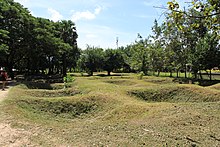
Back حقول قتل الخمير الحمر Arabic Killing Fields German Murdokampoj de la Ruĝaj Ĥmeroj EO Campos de la Muerte Spanish Champs de la mort French Polja smrti (Kambodža) Croatian Մահվան դաշտեր HY Ladang Pembantaian ID Killing fields Italian キリング・フィールド Japanese
This article may need to be rewritten to comply with Wikipedia's quality standards. (July 2024) |

| Part of a series on |
| Genocide |
|---|
 |
| Issues |
| Related topics |
| Category |


The Killing Fields (Khmer: វាលពិឃាត, Khmer pronunciation: [ʋiəl pikʰiət]) are sites in Cambodia where collectively more than 1.3 million people were killed and buried by the Communist Party of Kampuchea during Khmer Rouge rule from 1975 to 1979, immediately after the end of the Cambodian Civil War (1970–75). The mass killings were part of the broad, state-sponsored Cambodian genocide. The Cambodian journalist Dith Pran coined the term "killing fields" after his escape from the regime.[1]
The Khmer Rouge regime arrested and eventually executed almost everyone suspected of connections with the former government or foreign governments, as well as professionals and intellectuals. Ethnic Vietnamese, ethnic Thai, ethnic Chinese, ethnic Cham, Cambodian Christians, and Buddhist monks were the demographic targets of persecution. As a result, Pol Pot has been described as "a genocidal tyrant".[2] Sociologist Martin Shaw described the Cambodian genocide as "the purest genocide of the Cold War era".[3] In 1979, Vietnam invaded Democratic Kampuchea and toppled the Khmer Rouge regime, ending the genocide.
After five years of researching 20,000 grave sites, analysis indicates at least 1,386,734 victims of execution. Estimates of total deaths resulting from Khmer Rouge policies, including from disease and starvation, range from 1.7 to 2.2 million, out of a 1975 population of roughly 8 million. Even the Khmer Rouge acknowledged 2 million had been killed—though they attributed those deaths to the subsequent Vietnamese invasion.
By late 1979, UN and Red Cross officials were warning that another 2.2 million Cambodians faced death by starvation due to "the near destruction of Cambodian society under the regime of ousted Prime Minister Pol Pot",[4][5] who were saved by international aid after the Vietnamese invasion.
- ^ "'Killing Fields' journalist dies". BBC News. 30 March 2008. Retrieved 25 May 2010.
- ^ Branigin, William (17 April 1998). "Architect of Genocide Was Unrepentant to the End". The Washington Post. Archived from the original on 9 May 2013.
- ^ Theory of the Global State: Globality as Unfinished Revolution by Martin Shaw, Cambridge University Press, 2000, p. 141, ISBN 978-0-521-59730-2
- ^ The New York Times, 8 August 1979.
- ^ "Cambodia: Help for the Auschwitz of Asia". Time Magazine. 5 November 1979. Archived from the original on 13 September 2012.